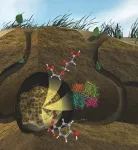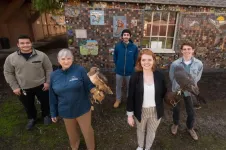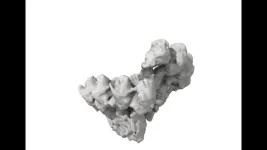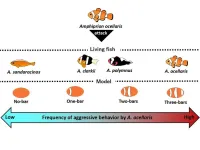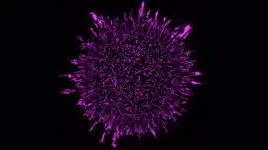(Press-News.org) Among the buzziest consumer technologies right now are “mixed reality” or “spatial computing” headsets that convincingly blend views of the real world with digital content.
A key enabling technology behind these gizmos is passthrough video, which involves blocking out all light so users must rely on cameras on the headsets to see the external world around them via real-time video playing on tiny screens. The arrangement allows users to physically interact with their environments and go about daily activities but with added digital content displayed, ranging from familiar device apps to innovative gaming scenarios. If tech companies’ visions come true, users would wear these headsets for extended periods, even all day long at work and at home, ushering in new modes of human-computer and social interaction.
To put passthrough video through its paces, a diverse team of Stanford researchers recently conducted field tests alongside longitudinal analyses of their personal journeys and interpersonal interactions. As described in a new study in Technology, Mind, and Behavior, overall user experiences proved – fittingly enough – mixed, with moments of both awe and unsettlement. The researchers accordingly recommend caution regarding prolonged headset use and call for a longer-term assessment.
“Given how far headsets with passthrough video have come, it’s time to dedicate serious academic thought to the psychological and behavioral effects of this technology,” said Jeremy Bailenson, the Thomas More Storke Professor in the Stanford School of Humanities and Sciences and founding director of the Virtual Human Interaction Lab (VHIL). “We want to understand the implications of living in a life in which we rely on passthrough for hours every day to see the world around us.”
Pros of passthrough
For the study, 10 research scholars in the VHIL and Bailenson himself spent at least 140 minutes over two or three sessions wearing Meta Quest 3 passthrough video headsets, which became widely available in October 2023.
The researchers engaged in a wide range of activities such as having conversations, walking outdoors, playing games, and eating and cooking food. For safety reasons, given concerns about potentially tripping over objects or encountering moving people or vehicles, a chaperone not wearing a headset remained present at all times.
The study participants attempted to examine the experience from both a hands-on, subjective perspective as well as a removed, clinical view. “We took an observational approach, more akin to naturalists, and really dove into the medium in an exploratory way,” said study co-author James Brown, a master’s student in the Symbolic Systems Program.
In general, the researchers found they enjoyed many aspects of having reality filtered through passthrough. “For a lot of us, wearing a headset in public was exciting,” said study co-author Monique Tania Santoso, a doctoral student in the Department of Communication.
“It was a very novel experience being in these headsets while walking around campus, interacting with strangers, and even buying coffee,” said co-author Portia Wang, a second-year master’s student in the Management Science and Engineering Department studying computational social science.
As for Bailenson, who has long followed the development of passthrough video and recalls first donning a rudimentary device back in the late 1990s, the experience was “mind-blowing” in comparison.
“It’s hard to describe until you try it, but it feels like magic with these newest headsets,” Bailenson said. “The immediacy of the video, the stereo color, and the incredible visuals that can be rendered, including making walls or objects disappear – your eyes and brain for the most part can’t tell the difference.”
Still not as real as real
As the researchers continued to spend time immersed in passthrough video, however, significant imperfections became apparent that impacted how users felt and would likely pose problems for frequent headset wearing.
In the headset, peripheral vision is lost and users can only take in around half of what humans normally see. And the gadgets still cannot quite match the sharpness of natural vision. Distortion occurs as well – a sort of “funhouse mirror” effect with objects’ shapes and dimensions appearing unnatural or morphing – and there was a just-noticeable lag in the display changing when users move their heads to a new view.
“Even though the world you are looking at is real, it certainly has a video-game-like ‘otherness’ to it,” said Brown.
These issues manifested as users often underestimating distances to objects. For example, giving “high fives” proved challenging, and when users tried bringing a spoon to their mouths when eating, the headset view suggested the spoon had reached their lips, though, in reality, the spoon hovered a few inches away.
While headset wearers learned to account for these inaccuracies, what concerns Bailenson’s team is the extent to which such overcompensation could linger after prolonged headset usage.
“The companies making these headsets want you to wear them all day, but what are the aftereffects and how long do they last?” Bailenson said. “A plausible scenario could be walking down a flight of stairs and you miss a step, or driving a car and you misjudge distances.”
All these effects contributed to profound feelings of what is known in this research as “social absence.” Instances of this included “challenges of discerning distant facial expressions,” noted by Wang, and the “lack of eye gaze,” reported by Santoso. “People in the outside world became very absent, as if we were watching them on TV,” Bailenson said. “The person walking or cycling by or sitting near you didn’t feel physically real.”
A final problem the team encountered in their field tests was simulator sickness, a kind of motion sickness long-documented in virtual reality and first-person gaming.
“When your eyes see the world move one way, and your body experiences it differently, simulator sickness can follow,” said Bailenson. “I was surprised because all 11 of us in this study are headset veterans, but even from relatively short periods of use, we tended to feel uncomfortable.”
Adapting and moderating
Given their experiences, the Stanford researchers recommend that mixed reality headset users proceed cautiously as they adjust to the medium rather than dive into day-long binges.
Bailenson specifically advocates for users of mixed reality products – as well as the headset manufacturers themselves – to consider reducing the amount of time in the headset and taking breaks.
“There is great potential for passthrough video headsets across all kinds of applications,” said Bailenson. “But there are pitfalls as well that can lessen the user experience, from feelings of social absence to motion sickness, and aftereffects that could possibly even be dangerous.”
Bailenson is a professor in the Department of Communication, a senior fellow at Stanford Woods Institute for the Environment, and a member of Stanford Bio-X, the Wu Tsai Human Performance Alliance, and the Wu Tsai Neurosciences Institute.
Additional Stanford authors include Brian Beams, lab manager of VHIL; graduate students Cyan DeVeaux, Eugy Han, Tara Srirangarajan, and Yujie Tao; and postdoctoral scholar Anna C. M. Queiroz.
Co-author Rabindra Ratan is from Michigan State University.
To read all stories about Stanford science, subscribe to the biweekly Stanford Science Digest.
END
Researchers take new ‘mixed reality’ headsets for a spin
2024-02-01
ELSE PRESS RELEASES FROM THIS DATE:
How leafcutter ants cultivate a fungal garden to degrade plants and provide insights into future biofuels
2024-02-01
By Maegan Murray
Scientists have spent decades finding ways to efficiently and affordably degrade plant materials so that they can be converted into useful bioproducts that benefit everyday life.
Bio-based fuels, detergents, nutritional supplements, and even plastics are the result of this work. And while scientists have found ways to degrade plants to the extent needed to produce a range of products, certain polymers such as lignin, which is a primary ingredient in the cell wall of plants, remain incredibly difficult to affordably break down without adding pollutants back into the environment. These polymers can be left behind as waste products with ...
UC Davis establishes bird flight research center
2024-02-01
Researching how bird flight can inform aircraft design is the goal of a new center to be established at the University of California, Davis.
Christina Harvey, an assistant professor of mechanical and aerospace engineering at UC Davis, and Michelle Hawkins, a professor in the School of Veterinary Medicine and director of the California Raptor Center, are launching the bird flight research center with a nearly $3 million grant from the Department of Defense. The new center will utilize motion capture and photogrammetry ...
ADA releases updated recommendations to enhance radiography safety in dentistry
2024-02-01
CHICAGO, Feb. 1, 2024 – The use of lead abdominal aprons or thyroid collars on patients when conducting dental X-rays is no longer recommended, according to an expert panel established by the American Dental Association (ADA) Council on Scientific Affairs. Additionally, dentists should take into consideration the diagnostic information needed from X-rays to benefit patient care or substantially improve clinical outcomes.
The Journal of the American Dental Association published the new recommendations today, which aim to improve radiation ...
Cheating death: How cancer cells escape
2024-02-01
Cell death is fundamental to life and, thus, healthy aging. In the realm of cellular biology, ferroptosis (a form of programmed cell death) has emerged not only as a focal point of research for its potential in eliminating cancer cells, but also its role in a plethora of other diseases, including neurodegenerative diseases such as Alzheimer’s disease, eye diseases such as Retinitis pigmentosa and age-related macular degeneration, as well as ischemia, cardiovascular disease, liver disease, acute kidney injury and inflammation.
While studies of other forms of cell death such as apoptosis focus largely on ...
JMIR Medical Informatics invites submissions on AI language models in health care
2024-02-01
JMIR Publications is pleased to announce a new section titled, “AI Language Models in Health Care” in JMIR Medical Informatics. This leading peer-reviewed journal is indexed in PubMed and has a unique focus on clinical informatics and the digitization of care processes. This section will have a broad focus and encompass topics about the successful implementation of artificial intelligence (AI) language models in diverse health care settings. The topics will include details about the process, use, outcomes, and ...
Human cells building ‘molecular highways’ captured for first time
2024-02-01
Researchers at the Centre for Genomic Regulation (CRG) in Barcelona and the Spanish National Cancer Research Centre (CNIO) in Madrid have captured the world’s first high-resolution images of the earliest moments of microtubule formation inside human cells. The findings, published today in the journal Science, lay the foundations for potential breakthroughs in treating many different types of diseases ranging from cancer to neurodevelopmental disorders.
“Microtubules are critical components of cells, but all the images we see in textbooks describing the first moments of their creation are models or cartoons based ...
Clown anemonefish seem to be counting bars and laying down the law
2024-02-01
We often think of fish as carefree swimmers in the ocean, reacting to the world around them without much forethought. However, new research from the Okinawa Institute of Science and Technology (OIST) suggests that our marine cousins may be more cognizant than we credit them for.
By observing how a colony of clown anemonefish (Amphiprion ocellaris) – the species of the titular character in Finding Nemo – reacts to intruders in their sea anemone home, OIST researchers have found that ...
New research shows that the arrangement of bacteria in biofilms affects their sensitivity to antibiotics
2024-02-01
Bacteria are traditionally imagined as single-cell organisms, spread out sparsely over surfaces or suspended in liquids, but in many environments the true bacterial mode of growth is in sticky clusters called biofilms. Biofilm formation can be useful to humans—it is integral, for example, to the production of kombucha tea. But it is more often problematic, because it makes it more difficult to control bacterial growth: When bacterial cells produce a biofilm, it acts as a shield against outside invaders, making the bacteria more ...
First atomic-scale 'movie' of microtubules under construction, a key process for cell division
2024-02-01
· Researchers at the Centre for Genomic Regulation (CRG) , the Spanish National Cancer Research Center (CNIO) and the IBMB-CSIC solve a key problem in biology: how human cells build their microtubules
· During cell division, microtubules function as nanometer-thick long ‘ropes' inside cells that pull chromosomes apart so that each daughter cell receives a copy of the genetic material
· The work published in Science lays the groundwork for future breakthroughs in the treatment of diseases ranging from cancer to neurodevelopmental disorders
Cells in the human body are constantly dividing. With each division the genetic information contained in the ...
Mapping the structure and organization of hippocampal neurons in the mouse brain
2024-02-01
Single-cell projectome analysis has revealed previously unknown spatial organization principles of the brain-wide structure and connectivity of more than 10,000 individual hippocampal neurons in the mouse brain, according to a new study. Specialized projections called axons allow neurons to transmit signals to other neurons across the brain. The hippocampus (HIP) – one of the most extensively studied brain regions – plays a crucial role in many crucial brain functions, including learning, memory, ...
